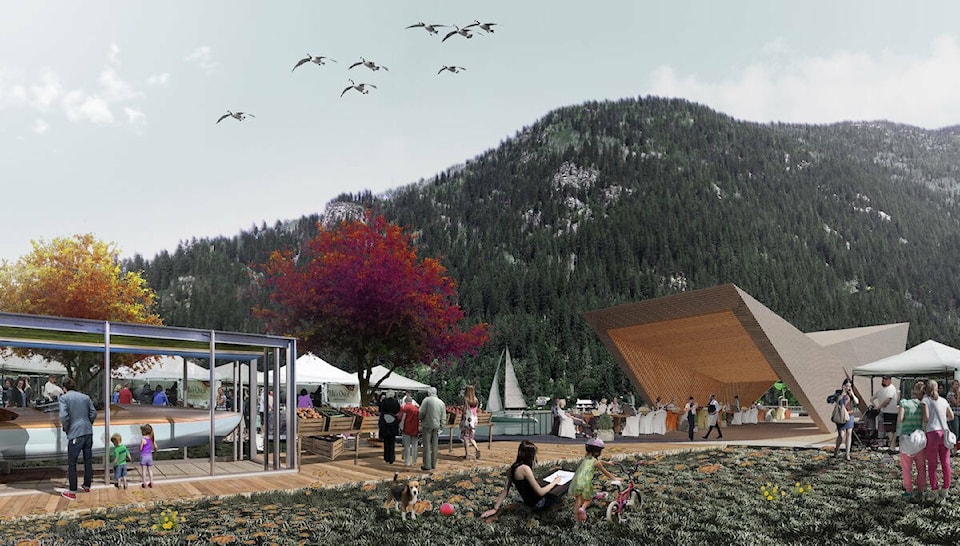Nelson council voted Friday to spend $861,000 on the original plan for a wooden canopy over the new Hall Street pier.
They made the decision after chief financial officer Chris Jury presented a business plan on how the canopy could be funded with revenues from events and parking at the site.
Voting in favour of the proposal were Councillors Keith Page, Jesse Woodward and Rik Logtenberg, along with Mayor Janice Morrison. Voting against were Councillors Jesse Pineiro and Leslie Payne.
Councillor Kate Tait recused herself from the discussion due to a potential conflict of interest.
At its Feb. 14 meeting, council had asked Jury to come up with a business plan because of uncertainty around the table about whether to fund the canopy, build a smaller version, build it of retractable canvas, or scrap it altogether.
The $861,000 cost of the canopy would raise the project cost to $4.6 million, which had already experienced increased costs due to inflation and pandemic-related supply chain issues. The original budget of $2.6 million was adjusted to $3.5 million in 2021. Grants from the province and the Columbia Basin Trust will cover $1.5 million of the project cost, with the rest to come from city construction reserves.
At the March 3 meeting Jury presented revenues and costs for three options: the original canopy, a scaled-back canopy, and no canopy. He said costs for a canvas canopy were not available.
For the original wood canopy Jury projected that the city could raise $12,200 annually from private events such as weddings (including perhaps renting it to the Prestige), and public events such as markets, concerts, and festivals, as well as from food vendors.
He also proposed that the parking lot on city property near the pier, now at an average of 40 per cent capacity, could increase its current earnings if there were more events at the site. He said total revenue from parking could be $35,492 annually.
The total of the projected parking and event revenue could be $47,692, he said. This is a mid-range estimate which could range between $63,090 and $30,294.
Jury said if revenue exceeds expenses in any given year, the excess would go to the Downtown Waterfront Reserve, and in the case of a deficit in any year the required funds could be drawn from there. This reserve fund is connected to the city’s Sustainable Waterfront and Downtown Master Plan, which guides future development and redevelopment in the downtown and waterfront areas.
Jury’s plan can be found by clicking the “canopy” link on the agenda at https://bit.ly/3SKskXe.
Logtenberg and Woodward change their minds
Councillors Rik Logtenberg and Jesse Woodward, who had been skeptical of this spending at the Feb. 14 meeting, said Jury’s analysis changed their minds.
They said they were confident that with this business plan the canopy would not draw funding from other priorities.
Logtenberg, who at the Feb. 14 meeting had advocated lowering the cost by using a retractable canvas canopy, said he had researched this and found that canvas coverings need replacing frequently. He acknowledged that in the summer there would be a need for shade on the pier.
The canopy and the planned swimming area could become a place families gather while its tramway connection to Lakeside Park could be an attraction, he said, adding that the canopy would act as an anchor for events such as night markets and concerts.
Woodward said he has begun to see the canopy as a valuable 40- to 50-year asset that will be identified with Nelson through tourist photos.
“It will be an iconic piece like the orange bridge that goes out into the world.”
Pineiro and Payne
Councillor Jesse Pineiro said Jury’s business plan makes sense but “the issue for me is that we are potentially being forced into the hyper-monetization of public space, in order to pay for something that we may or may not really need.”
He said Nelson has several successful markets that operate without canopies, and the argument that it could be used year-round for anything is optimistic because “it is freezing down there and I don’t know that a roof would change that.”
He said there is no need for a landmark when the lake and the mountain are beautiful already, and that the city could easily spend the $860,000 elsewhere.
Councillor Leslie Payne agreed with Pineiro on the monetization of public space and on the winter weather. She said Nelson has many “amenity spaces” already including the Hall Street Plaza, Cottonwood Park, and Lakeside Park, and wondered how many events the city expects to put on, especially in the winter.
“I have not heard yet a reason for me to feel that we need to complete this wooden canopy at this price,” Payne said, “or that would shift me away from looking at the huge scope of other projects that we do have out there.”
She said the city is committed to 100 per cent renewable energy and to implementing the Nelson Next climate plan in other ways. She said that will be expensive and the costs are as yet unknown.
She said all of the revenue listed in Jury’s analysis could be raised anyway, with or without a canopy.
Council’s decision to fund the canopy means it will be built this year.
READ MORE:
• Nelson council puts Hall Street pier canopy on hold for further study
bill.metcalfe@nelsonstar.com
Like us on Facebook and follow us on Twitter
